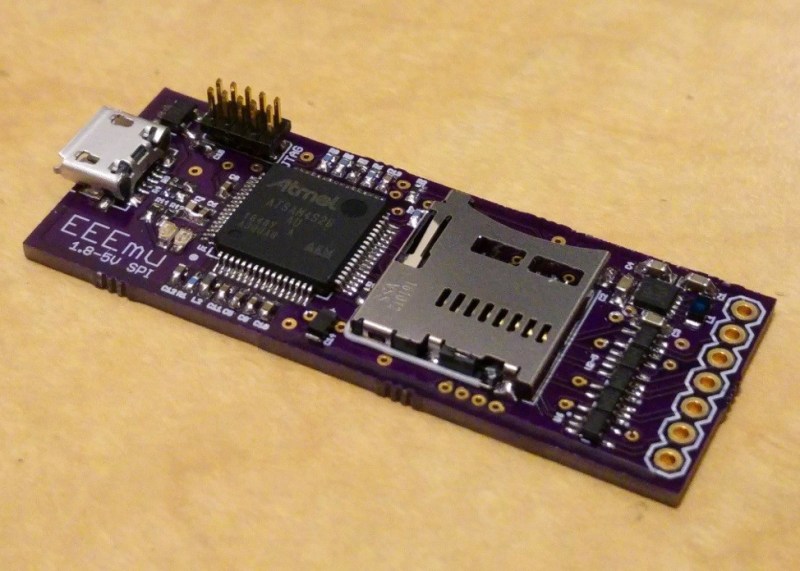For this year’s Hackaday Prize, we’re giving everyone the opportunity to be a hardware startup. This is the Best Product portion of the Hackaday Prize, a contest that will award $30,000 and a residency in our Design Lab to the best hardware project that is also a product.
Imagine all the memory chips in all the landfills in the world. What if we could easily recover those hosed motherboards and swap out ROM files on malware-damaged chips. That’s the promise of [Blecky]’s EEPROM/Flash Emulator project on Hackaday.io. This project seeks to be the ultimate memory interface, emulating SPI-interface EEPROM or Flash memory chipsets with ease. It can also be used as a security device, checking the BIOS for untoward changes.
The EEEmu packs an Atmel SAM4S Cortex-M4 processor-based microcontroller, an SD card reader, a micro USB for reprogramming, boost converter, voltage regulator, and includes additional 3.3V GPIO/I2C ports, all on a wee 51.5x20mm circuit board. Version 2 is slated to include more features to facilitate use as a normal micro controller: more GPIO pins, USB voltage monitoring, and high-Z control for SPI output.
EEEmu is completely open source, with [Blecky] sharing his code on GitHub and even has created an EEEmu Fritzing part, also found in his repository.




















Really needs an illustration that is a play on Total Recall!
Take my money.
This would allow you to bypass the BIOS security on laptops too. There are certain legitimate reasons for needing to do that, and a whole lot of nefarious ones.
This might be quite useful for developing coreboot / libreboot ports.
Sort of off topic but the Harmony Cart for the Atari 2600 is a memory emulator using a inexpensive ARM processor. It also handles all the proprietary bank switching in code as well. A generic memory emulator should be quite useful.
This is so much easier today with serial memory interfaces, especially when they’re latency tolerant.
If you wanted to build a parallel ROM emulator for say, a car’s ECU. They were anywhere from 8 to 16 bit data bus was common back then, and if they didn’t work within the same latency as original things might go badly. Not hard if just doing RAM replacement of ROM, that’s easy, but if you wanted to be able to update the contents of RAM arbitrarily via an attached laptop or similar (so you could re-tune the fuel/timing/etc maps on the fly), that got trickier to DIY.
TAKE MY MONEY!!!!!!!!This is what I need right now!
Got a latitude E6400 spare for when and if my usual one breaks down…. however I’ve bodged an IC socket below the
Alt Grkey ready to try out some core-boot bodging (Aaaagg… too many projects on the go again, thanks brain for reminding me!).Once I get a display on the E6400…. All good ;)
This can be used to emulate the SPI ROM and significantly speed up production faster than I could type “make install && reboot”.
Where are sources, schematics and doc? GitHub repos are empty and website just points to the hackaday page…
Would love to have a look at it.
empty repos are empty.